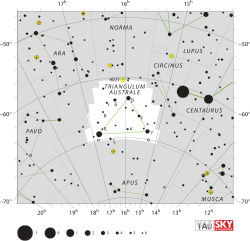Alpha Trianguli Australis

| |
| Observation data Epoch J2000 Equinox J2000 | |
|---|---|
| Constellation | Triangulum Australe |
| Right ascension | 16h 48m 39.89508s[1] |
| Declination | –69° 01′ 39.7626″[1] |
| Apparent magnitude (V) | 1.91[2] |
| Characteristics | |
| Spectral type | K2 IIb-IIIa[3] |
| U−B color index | +1.56[4] |
| B−V color index | +1.44[4] |
| Astrometry | |
| Radial velocity (Rv) | –3.3[2] km/s |
| Proper motion (μ) | RA: 17.99[1] mas/yr Dec.: –31.58[1] mas/yr |
| Parallax (π) | 8.35 ± 0.15[1] mas |
| Distance | 391 ± 7 ly (120 ± 2 pc) |
| Absolute magnitude (MV) | –3.68[5] |
| Details | |
| Mass | 7[3] M☉ |
| Luminosity | 5,500[5] L☉ |
| Surface gravity (log g) | 1.5[3] cgs |
| Temperature | 4,150[3] K |
| Metallicity [Fe/H] | –0.06[3] dex |
| Age | 4.8 × 107[3] years |
| Other designations | |
| Database references | |
| SIMBAD | data |
Alpha Trianguli Australis (α Trianguli Australis, abbreviated Alpha TrA, α TrA), also named Atria,[7] is the brightest star in the southern constellation of Triangulum Australe, forming an apex of a triangle with Beta and Gamma Trianguli Australis that gives the constellation its name (Latin for southern triangle).
Nomenclature
α Trianguli Australis (Latinised to Alpha Trianguli Australis) is the star's Bayer designation. The historical name Atria is a contraction.[8][9] In 2016, the International Astronomical Union organized a Working Group on Star Names (WGSN)[10] to catalog and standardize proper names for stars. The WGSN's first bulletin of July 2016[11] included a table of the first two batches of names approved by the WGSN; which included Atria for this star.
In traditional Chinese it is called 三角形三 (Mandarin: sān jiǎo xín sān), the Third Star of the Triangle.
Properties
Alpha Trianguli Australis is a bright giant star with an apparent magnitude of +1.91. Based upon parallax measurements, this star is located roughly 391 light-years (120 parsecs) distant from the Earth.[1] The estimated age of the star is 48 million years old; sufficiently old for a massive star to evolve away from the main sequence and expand into a giant.[3] It has a mass roughly seven times the mass of the Sun, but is emitting about 5,500 times the Sun's luminosity. The effective temperature of the star's outer envelope is 4,150 K,[3] which gives it the characteristic orange hue of a K-type star.[12] With a diameter 130 times that of the Sun, it would almost reach the orbit of Venus if placed at the centre of the Solar System.
There is evidence that Atria may be a binary star. It displays unusual properties for a star of its class, including stellar flares and a higher than normal emission of X-rays. These can be explained by a young, magnetically active companion with a stellar classification of about G0 V. Such a star would have a mass similar to the Sun, with an orbital period of at least 130 years. Young, G-type stars have a high temperature corona and frequently emit flares causing sudden increases in luminosity. The pair may be separated by about 50 Astronomical Units.[5]
In culture
Atria appears on the flag of Brazil, symbolizing the state of Rio Grande do Sul.[13]
References
- 1 2 3 4 5 6 van Leeuwen, F. (November 2007). "Validation of the new Hipparcos reduction". Astronomy and Astrophysics. 474 (2): 653–664. arXiv:0708.1752
 . Bibcode:2007A&A...474..653V. doi:10.1051/0004-6361:20078357.
. Bibcode:2007A&A...474..653V. doi:10.1051/0004-6361:20078357. - 1 2 Wielen, R.; et al. (1999), "Sixth Catalogue of Fundamental Stars (FK6). Part I. Basic fundamental stars with direct solutions", Veröff. Astron. Rechen-Inst. Heidelb, Astronomisches Rechen-Institut Heidelberg, 35 (35), Bibcode:1999VeARI..35....1W
- 1 2 3 4 5 6 7 8 Kovacs, N. (April 1983), "Model-atmosphere analysis of high-dispersion spectra of four red giants and supergiants", Astronomy and Astrophysics, 120 (1): 21–35, Bibcode:1983A&A...120...21K
- 1 2 Johnson, H. L.; et al. (1966). "UBVRIJKL photometry of the bright stars". Communications of the Lunar and Planetary Laboratory. 4 (99): 99. Bibcode:1966CoLPL...4...99J.
- 1 2 3 Ayres, Thomas R.; Brown, Alexander; Harper, Graham M. (April 2007), "α TrA Junior", The Astrophysical Journal, 658 (2): L107–L110, Bibcode:2007ApJ...658L.107A, doi:10.1086/514818
- ↑ "alf TrA -- Star", SIMBAD, Centre de Données astronomiques de Strasbourg, retrieved 2011-12-26
- ↑ "IAU Catalog of Star Names". Retrieved 28 July 2016.
- ↑ Ridpath, Ian (1989), Star tales, James Clarke & Co., p. 125, ISBN 0-7188-2695-7
- ↑ Kaler, Jim. "Atria (Alpha Trianguli Australis)". Stars. University of Illinois. Retrieved 17 October 2012.
- ↑ "IAU Working Group on Star Names (WGSN)". Retrieved 22 May 2016.
- ↑ "Bulletin of the IAU Working Group on Star Names, No. 1" (PDF). Retrieved 28 July 2016.
- ↑ "The Colour of Stars", Australia Telescope, Outreach and Education, Commonwealth Scientific and Industrial Research Organisation, December 21, 2004, retrieved 2012-01-16
- ↑ "Astronomy of the Brazilian Flag". FOTW Flags Of The World website. Retrieved 2011-12-26.
External links
- Kaler, James B., "ATRIA (Alpha Trianguli Australis)", Stars, University of Illinois, retrieved 2011-12-26